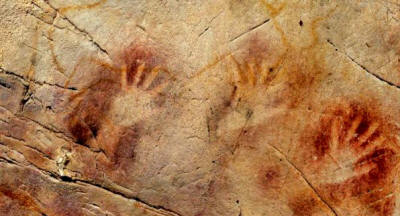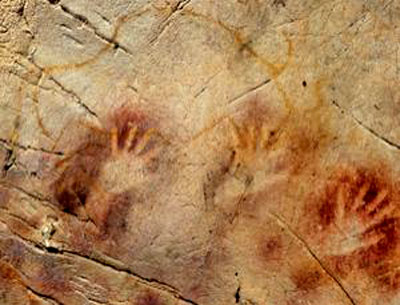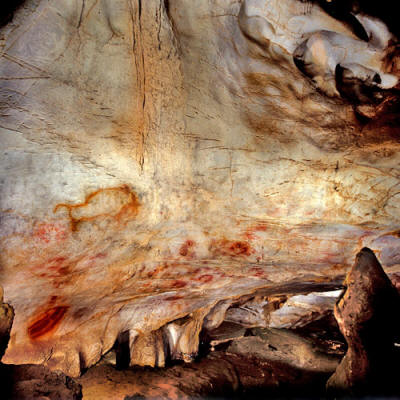|

by Susanne Posel
June 23, 2012
from
OccupyCorporatism Website

Scientific research is becoming easier and easier now that
archaeologists can simply make-up their own way of carbon dating and
come forth with new information that challenges accepted facts.
Alistair Pike, an archaeologist at the University of Bristol in
England, believes that some of the famous cave paintings in Spain
were drawn by Neanderthals , not humans.
Known as the Panel of Hands in the cave of El Castillo, Spain,
ongoing tests on 50 paintings in 11 caves are purported to be
the
work of Neanderthals.
Pike used a novel method of dating the paintings and has concluded
that,
“we must entertain the possibility that these paintings were
made by Neanderthals.”
According to Pike, the paintings in Spain are nearly 40,800 years
old. This was the same time frame that Neanderthals were dominant in
Europe. Modern humans are proposed to be still in Africa around
300,000 years ago.
Joao Zilhao, an archaeologist with the University of Barcelona, and
part of Pike’s team says that his gut tells him this art was created
by Neanderthals.
“We can’t be 100 percent certain that they did it.
I think that there is a strong probability. My point is the evidence
for symbolic behavior among the Neanderthals already exists.”
Zilhao points to evidence that Neanderthals buried their dead,
placed objects in graves and created jewelry as proof that they most
likely responsible for these famous cave paintings.
However,
disregarding real data for circumstantial evidence is not making
good use of the scientific method.
These paintings of shapes, animals and hand stencils could give
scientists a glimpse into the cognitive capacity of our human and
Neanderthal ancestors; as well as their ability to formulate
language, abstract thought, and other brain functions that though
evolved separately, are important to understanding these two
parallel human lineages.
It is generally accepted, Pike asserts, that human and Neanderthals
interbred.
This is still scientific theory; however Pike feels that
by saying it is fact, he can make it so. Still Pike wants the
scientific community to see his theories as explanations for the
symbolic thinking of Neanderthals, which is truly an attempt to
rewrite history.
Although Pike’s assertions are not so much based on scientific data,
but rather assumptions from his own technique of carbon dating, the
question he poses is:
“Why should it be surprising that
Neanderthals produced art?”
John Hellstrom, from the University of
Melbourne in Australia,
praises Pike’s research because it is
challenging scientific facts about human evolution. Hellstrom says:
“The scope of their study has
allowed them to unambiguously identify a number of examples that
challenge and overturn the previous understanding of that art’s
origin.”
Archaeologist Pat Shipman asks why
Neanderthals waited for modern humans to arrive in Europe before
beginning to paint?
Shipman logically points out:
“OK, Neanderthals had been there for
300,000 years, and they’re not doing this. If they are not doing
it before, why would they suddenly start doing it at that
point?”
- Neanderthals Writings?
-
Oldest Confirmed Cave Art
...Is
A Single Red Dot
by
Michael Marshall
20 June 2012
from
NewScientist Website
As cave art goes, it doesn't look like
much: a single red dot, hidden among a scatter of handprints and
drawings of animals on the wall of
El Castillo cave in northern Spain.
But this red dot is at least 40,800 years old, making it the oldest
known piece of cave art in Europe.
At that time modern humans had only just
migrated out of Africa, raising a tantalizing possibility: that the
dot was drawn by a Neanderthal. If that's the case, our extinct
cousins may have had the rudiments of written language.
While cave art is common throughout western Europe, the oldest dated
examples are those in
Chauvet cave in France, which have
controversially been dated to between 35,000
and 30,000 years ago.

A hand stencil in El
Castillo cave, Spain, has been dated to earlier than 37,300 years
ago
and a red dot to
earlier than 40,600 years ago, making them the oldest cave paintings
in Europe
(Image: Pedro Saura)

Zoomed-out view of the cave art in El Castillo cave, Spain
(Image: Pedro Saura)
But many other pieces of cave art have
never been dated. Standard radiocarbon dating only works when
paintings were made using organic material like charcoal.
Anything drawn with minerals like ochre,
or just carved into the wall, can not be carbon dated.
Uranium age
trick
Now, Alistair Pike
of the University of Bristol, UK,
and colleagues have come up with a partial solution that will put a
minimum age on some previously un-datable paintings.
As water seeps through rock and dribbles over the cave surface, it
leaves behind a thin layer of calcite. This contains radioactive
uranium, which slowly decays into thorium at a known rate.
So, by measuring how much uranium has decayed into thorium, Pike
figured he could determine the age of the calcite layer.
If the calcite overlays a painting, it will provide a minimum age
for that art.
In El Castillo, the red dot lay beneath the oldest dated calcite
layer. Others came close: a red hand shape on the same wall was at
least 37,300 years old and a symbol that looks like the number "1"
in the nearby Altamira cave was at least 35,600 years old.
The result makes these drawings the oldest known pieces of cave art
in the world - so far. Pike is already examining art in other
European caves to see if he can top his latest find.
Some Australian rock art apparently depicts
birds that have been extinct for 40,000 years,
but most of it has
not been chemically dated.
Neanderthal artist?
The Spanish cave art is so old that it may not have been painted by
modern humans.
Homo sapiens arrived in Europe
sometime between 42,000 and 40,000 years ago - right around the
minimum age of the art. Yet
Neanderthals had already been on
the continent for tens of thousands of years.
So who did the painting?
The fact is we don't know. If modern humans were the artists, they
either brought the practice with them from Africa - but left little
trace of it there - or developed it incredibly quickly once they
reached Europe. Pike suggests that humans changed their culture
rapidly when they started competing with the Neanderthals.
Cave art, he says, was a by-product of
these changes.
"That would explain why it happened
so quickly," he says.
The other possibility is that the
paintings were done by the Neanderthals. The paintings could have
been made thousands of years before they were covered in calcite. If
so, Neanderthals are the only plausible candidates.
That might not be such a stretch: Neanderthals
used crayon-like pigments to draw
on themselves and even
made simple jewellery. And there is
other, indirect evidence that European caves were adorned around the
time modern humans got there.
Earlier this year, a team led by José
Luis Sanchidrián Torti
of the University of Córdoba,
Spain, claimed that cave paintings found in the south of the
country, near Malaga,
were over 42,000 years old and therefore drawn
by Neanderthals.
The team dated nearby charcoal pigments,
not the paintings themselves, and have not published their data.
What does it mean?
Although
dramatic drawings of large animals
tend to be the focus of attention, most cave art consists of simple
symbols like the ones Pike studied.
April Nowell
of the University of Victoria in
British Columbia, Canada, and her colleague Genevieve von
Petzinger have found the same symbols drawn all over the world,
so they may represent an
early form of graphic communication.
Could this mean Neanderthals were able
to write? Only the discovery of similar, but older symbols will say
for sure. If you find Neanderthals writing hard to believe, get
this: an alternative interpretation of the hand stencils suggests
they are the leftovers of early religion.
Paul Pettitt of the University of Sheffield, UK - one of
Pike's collaborators - has just completed an extensive study of the
hand stencils, which are found in El Castillo and elsewhere.
His as-yet-unpublished data shows the symbols tend to be placed in
places that are difficult to reach.
"One involves a climb up a slippery
stalactite," he says.
Others are found up chimneys.
"They seem to be marking passages
off the main areas," Pettitt says.
One interpretation is that they are
signposts, perhaps saying "do not go this way".
They may have a more profound meaning. Pettitt found that they were
often placed over cracks in cave walls, or right next to them. Such
cracks, he says, may have been seen as gateways to a supernatural
world. He points out that caves are often associated with the
supernatural, in part because they are dark and quiet, and people's
sense of time is altered if they spend time in them.
Similar ideas have been put forward by Jean Clottes, who
excavated Chauvet, and David Lewis-Williams of the University
of Witwatersrand in South Africa.
They have linked cave art with
shamanism, and suggest that early humans saw the cave wall as a veil
between this world and the next.
"I would have to see Pettitt's study
and see what the stats are like," Nowell says.
"I can think of many examples of
hands not near cracks," she adds, and it is also impossible to
determine the symbols' meaning. "But these are things that have
been said in one form or another before and no one has been able
to test for meaning scientifically."
Whether or not the use of caves as
religious sites goes right back to the arrival of humans in Europe,
for now, remains shrouded in history.
Note: Journal
reference: Science, DOI: 10.1126/science.1219957 (U-Series
Dating of Paleolithic Art in 11 Caves in Spain).
|




